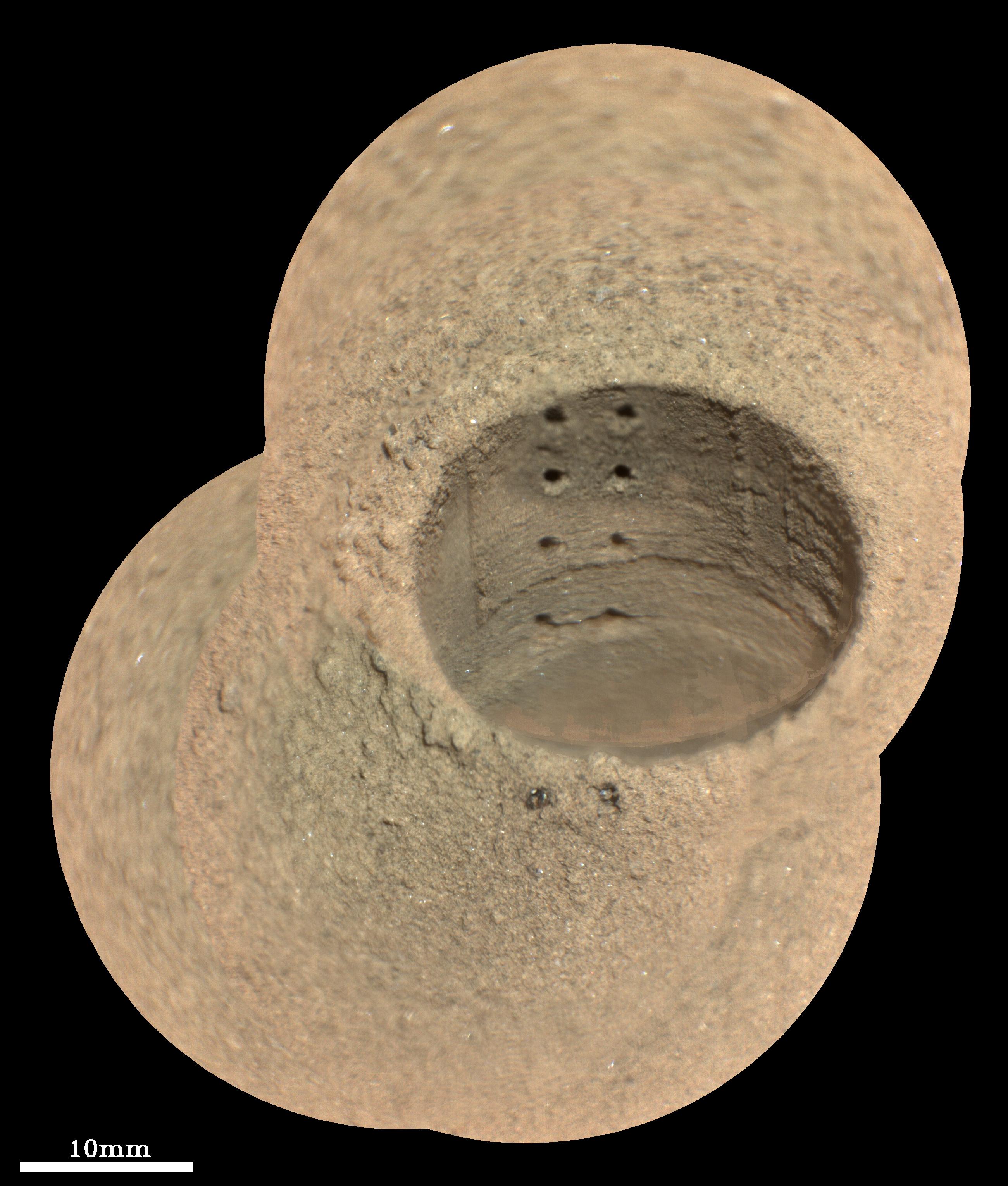
|
Laser Shots at Roubion
- Click the image above for a larger view
- Full-Res JPEG (2601 x 3061) (682.8 kB)
- Full-Res TIFF (2601 x 3061) (15.9 MB)
Caption:
This composite image, made from four taken by the SuperCam instrument aboard NASA's Perseverance rover on August 8, 2021, shows the hole in a Martian rock where the rover attempted to collect its first sample; the small pits within it were created by laser zaps from SuperCam during subsequent efforts to analyze the rock's composition. The rover science team has nicknamed the drill hole "Roubion." The team believes that because of this rock's unusual composition, the process of extracting a core created a significant pile of tailings (or cuttings) around the coring hole.
Eight pits produced by 30 laser shots each are seen in two columns inside the drill hole. The SuperCam team's analysis suggests that the top six pits penetrated the compacted mound of tailings around the hole, while the bottom two pits in the hole interrogated material below the rock surface. Two additional laser pits can be seen in the tailings at the near side of the hole.
Two vertical ridges inside the hole – one on each side of the laser pits – were produced as the drill was removed, prior to laser analysis. Some bright mineral grains can be seen as glints in the tailings and in the drill hole. A few clumps or larger pieces of material are seen at the top of the tailings pile just to the left of the hole.
The SuperCam images were taken from a distance of 7.32 feet (2.23 meters). A scale bar is included in this image.
An additional animation shows a series of images covering the time the distinct laser holes were made at Roubion, plus additional images through August 10, 2021, when SuperCam zapped five more overlapping, nearly horizontal holes.
Perseverance landed in Mars' Jezero Crater on February 18, 2021, and has been exploring the floor of the crater since. At the time these images were taken, Perseverance was in an area nicknamed the "Crater Floor Fractured Rough" area.
Background Info:
SuperCam is led by Los Alamos National Laboratory in New Mexico, where the instrument's Body Unit was developed. That part of the instrument includes several spectrometers as well as control electronics and software.
The Mast Unit, including the Remote Microscopic Imager used for these images, was developed and built by several laboratories of the CNRS (the French research center) and French universities under the contracting authority of Centre National d'Etudes Spatiales (CNES, the French space agency).
A key objective for Perseverance's mission on Mars is astrobiology , including the search for signs of ancient microbial life. The rover will characterize the planet's geology and past climate, pave the way for human exploration of the Red Planet, and be the first mission to collect and cache Martian rock and regolith (broken rock and dust).
Subsequent NASA missions, in cooperation with ESA (European Space Agency), would send spacecraft to Mars to collect these sealed samples from the surface and return them to Earth for in-depth analysis.
The Mars 2020 Perseverance mission is part of NASA's Moon to Mars exploration approach, which includes Artemis missions to the Moon that will help prepare for human exploration of the Red Planet.
NASA's Jet Propulsion Laboratory in Southern California built and manages operations of the Mars 2020 Perseverance rover for NASA.
For more about Perseverance: mars.nasa.gov/mars2020/ and nasa.gov/perseverance
Cataloging Keywords:
| Name | Value | Additional Values |
|---|---|---|
| Target | Mars | |
| System | ||
| Target Type | Planet | |
| Mission | Mars 2020 | |
| Instrument Host | Perseverance | |
| Host Type | Rover | |
| Instrument | SuperCam | |
| Detector | ||
| Extra Keywords | Color, Crater, Dust, Moon | |
| Acquisition Date | ||
| Release Date | 2021-08-12 | |
| Date in Caption | 2021-02-18 | 2021-08-08, 2021-08-10 |
| Image Credit | NASA/JPL-Caltech/LANL/CNES/IRAP | |
| Source | photojournal.jpl.nasa.gov/catalog/PIA24749 | |
| Identifier | PIA24749 | |
